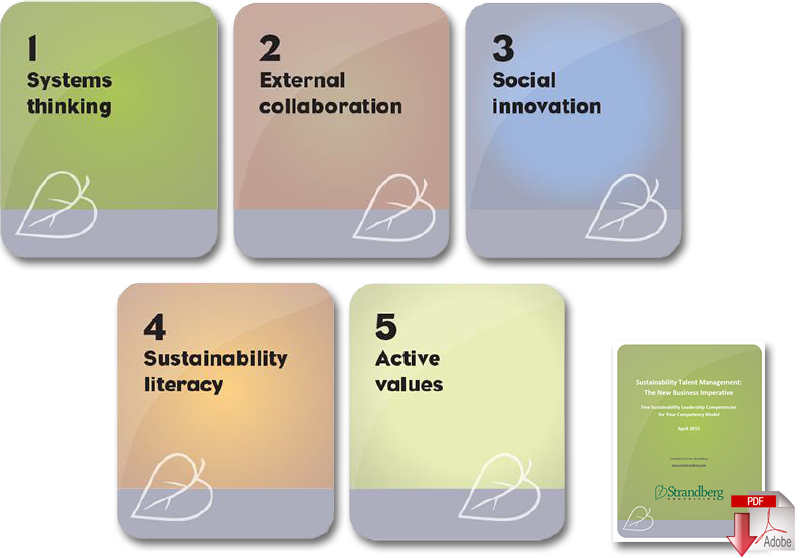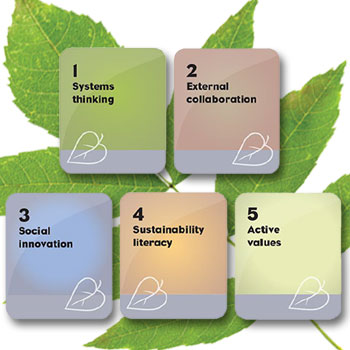5 Core Competencies of Sustainability Leadership

A competency model is a roadmap for seeking and developing ideal employees. In short, it defines the criteria guiding HR processes such as recruitment and selection, training and development, and compensation.
What competencies should a company’s leadership demonstrate to ensure its future success?
When I say “future success,” I really mean “future existence,” which certainly can be a mark of success for any company.
Anyone in the GreenBiz choir understands that companies today must adopt forward-thinking approaches to secure access to resources and maintain their social license to operate.
Company leaders, regardless whether they adorn a sustainability title, must demonstrate comfort managing systemic change and navigating complex, interdependent business networks.
Upgrading competency models for sustainability
Following suit from a human resources perspective, companies have the opportunity to incorporate sustainability and long-termism into their competency models to attract leaders of tomorrow.
I’m talking about the entire C suite here, not just the CSO.
A competency model is a roadmap for seeking and developing ideal employees. In short, it defines the criteria guiding HR processes such as recruitment and selection, training and development, and compensation.
What does a competency model geared towards sustainability look like?
Coro Strandberg’s recent work may provide an answer. I’m a big fan of Strandberg; I’ve included her sustainability strategy expertise in previous articles.
Strandberg Consulting’s latest report is Sustainability Talent Management: The New Business Imperative. It distills a decade of sustainability and management literature into five interdependent competencies.
Putting it in perspective
To understand how HR departments might adopt these five competencies, I asked Strandberg how they differ from generic models. She said:
These competencies do not replace but build on and extend conventional competencies. As such, they represent higher levels of performance for executives. Taken together, these competencies represent a shift in thinking of the organization as an isolated entity to an organization as part of a value network or broader economic eco-system. They foster a shift in perspective from a shareholder orientation to a social purpose and stakeholder orientation. And they encourage professionals to connect their work with their personal ethical and humanitarian values rather than leave them at home. Sustainability and HR managers find that these sustainability competencies address gaps in their current models.
The following five competencies, as defined by Strandberg, are essential for any organization as they update their talent management strategies and traverse the dynamic sustainability terrain ahead.
The 5 Sustainability Competencies

1. Systems Thinking
This is the connected, holistic thinker. Systems thinkers understand the context behind a problem and its relationship to broader trends. For example, a sustainability leader grasps the system of relationships in which business is embedded: Supply chains; industries; cities; regions; and ecosystems.
Systems thinkers often have multidisciplinary backgrounds combining technical and creative fields. They also may have expertise in principles of systems management such as resilience and managing for emergence.
2. External Collaboration
Leaders must be willing to work with entities beyond business. A significant portion of a business’ environmental impact may be found up or downstream of its operations, meaning collaboration with suppliers, customers and even competitors is necessary. Collaboration helps companies build social capital, explore new market opportunities and shape the contexts in which they operate.
We’ve seen great examples of this teamwork: more businesses are investing in partnerships with NGOs to tackle social issues, and industry collaborations such as the Sustainable Apparel Coalition are growing.
3. Social Innovation
The magnitude of sustainability challenges demands a fundamental re-engineering of business. Leaders with social innovation competence view this challenge as a growth opportunity.
Social innovators find ways to redesign products and processes that create business and social value. They question the status quo and treat constraints as transformable. Within organizations, innovative leaders encourage social entrepreneurship among employees and prioritize interdisciplinary teams.
4. Sustainability Literacy
Sustainability-literate leaders are aware of emerging environmental and social trends, and the risks and opportunities they create for business.
Fundamentally, they understand the changing role of business in society, how peer organizations are responding and available methods to revise business models. These may include conducting environmental and social cost accounting, or using tools for scenario planning, back-casting, hot spot and materiality analyses.
5. Active Values
A leader with active values is mindful of emotions and motivations and sensitive to those of others. Mindful leaders can view themselves and their work as part of a larger purpose, motivating them to harness business to improve society.
Strandberg said this emotional intelligence fosters resiliency, trust and reciprocity among co-workers and external stakeholders. Empathetic leaders also may innovate products aligned with values that are relevant to customers’ genuine needs.
I encourage you to share Strandberg’s report with your HR team. It may lead to a shift in competency models, or at least a lively conversation.
Source: GreenBiz
Related: Tiffany & Co.‘s New Chief Sustainability Officer on Polishing the Jewelry Supply Chain

Article Topics
ASCM News & Resources
Supply Chain Stability Index sees ‘Tremendous Improvement’ in 2023 Supply Chain Stability Index: “Tremendous Improvement” in 2023 The Right Approach for Supply Chain Education The reBound Podcast: Innovation in the 3PL supply chain Supply Chain’s Top Trends for 2024 Require Talent Investment for Success Resilience Certificate Now Available from ASCM ASCM conference highlights importance of geopolitics in the supply chain More ASCMLatest in Supply Chain
TIm Cook Says Apple Plans to Increase Investments in Vietnam Amazon Logistics’ Growth Shakes Up Shipping Industry in 2023 Spotlight Startup: Cart.com is Reimagining Logistics Walmart and Swisslog Expand Partnership with New Texas Facility Nissan Channels Tesla With Its Latest Manufacturing Process Taking Stock of Today’s Robotics Market and What the Future Holds U.S. Manufacturing Gains Momentum After Another Strong Month More Supply Chain














